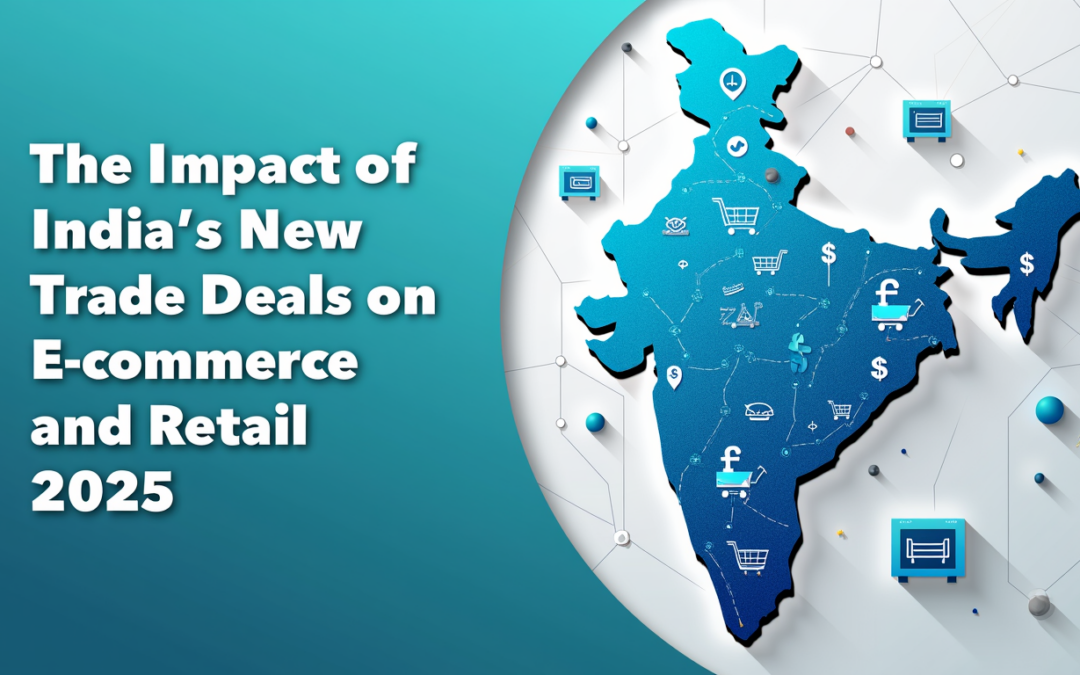The Impact of India’s New Trade Deals on Ecommerce and Retail (2025)
India is changing fast. New trade deals are helping businesses grow. In 2025, these deals lower costs, make shipping easier, and open up new markets for both online stores and physical shops. In this post, we will explain what these trade deals are, how they affect ecommerce and retail, and what opportunities and challenges they bring. We will also share simple steps to help your business benefit from these changes.
What Are Trade Deals?
Trade deals are agreements between two or more countries. They set rules for buying and selling goods across borders. Recently, India has signed many new trade agreements with countries in Asia, Europe, and even the United States. These deals help by lowering taxes on imported goods and reducing paperwork. This makes it cheaper and easier for Indian businesses to buy and sell products around the world.
When tariffs (taxes on imports) are reduced, it saves money. Lower costs mean that products can be sold at lower prices or with better profit margins. This is very good for ecommerce and retail businesses.
How Do Trade Deals Help Ecommerce?
Lower Import Costs
When trade deals lower tariffs, businesses pay less for imported materials. For example, an electronics store that buys parts from abroad may save money. This means:
- Lower Production Costs: Companies spend less on making products.
- Better Prices for Customers: Savings can be passed on to buyers, making the store more competitive.
- Higher Profits: Lower costs can also mean more profit.
Improved Supply Chain and Faster Shipping
New trade deals make customs procedures simpler. This means products move faster from factories to your warehouse. A smoother supply chain is important because:
- Faster Delivery: Customers get their orders quickly.
- Fewer Delays: There are fewer problems at the border.
- Stable Supply: The chance of running out of products is reduced.
More Market Access
Trade deals open new markets. Indian ecommerce brands can now sell their products in more countries. This helps with:
- Expanding the Customer Base: More people can buy your products.
- Global Reach: Your brand can become known around the world.
- International Trade: Lower trade barriers make it easier for Indian brands to join global trade.
Digital Transformation and Technology
These deals push businesses to use digital tools. Modern digital technologies help companies:
- Track Inventory: Better supply chain management software makes it easier to keep stock.
- Improve Efficiency: Digital transformation helps cut costs and speed up business processes.
- Use Data: Tools for demand forecasting help predict what products will be popular.
How Do Trade Deals Affect Retail?
Trade deals are not just good for online stores. They also change how physical retail works in India.
Better Access to Products
Lower import taxes mean that retailers can bring international products into their stores more cheaply. This helps because:
- More Choices for Customers: Shoppers can choose from a wider range of products.
- Better Prices: Lower costs help retailers offer competitive pricing.
- Higher Sales: More variety and lower prices attract more buyers.
Stronger Local Production
Many new trade deals also support local manufacturing. The government of India offers incentives for companies that produce goods locally. This helps in several ways:
- Improved Quality: Local products can be checked more easily for quality.
- Faster Production: Products made in India reach the market faster.
- Support for ‘Make in India’: This boosts the overall quality and reputation of Indian products.
Enhanced Infrastructure
Trade deals often lead to more investment in roads, ports, and digital systems. Improved infrastructure means:
- Faster Shipping: Better roads and ports help move products quickly.
- Lower Costs: More efficient transport reduces shipping costs.
- Better Business Processes: With modern information technology, companies can work more smoothly and efficiently.
Opportunities for Indian Businesses
New trade deals create many opportunities for both ecommerce and retail businesses. Here are some key benefits:
1. Lower Costs and Cost Savings
With lower tariffs, businesses can save money on importing materials. These cost savings allow companies to:
- Lower product prices for customers.
- Enjoy higher profit margins.
- Invest savings in other parts of the business.
2. Market Expansion
Trade deals help businesses reach new markets. With fewer trade barriers, Indian brands can export more products. This opens up:
- New customer bases in other countries.
- Better growth opportunities and long-term success.
- More exposure for the brand on a global scale.
3. Improved Supply Chains
A smoother supply chain means products are delivered faster and with fewer delays. This gives businesses:
- Reliable supply of products.
- Better customer service.
- A strong competitive advantage in both local and international markets.
4. Boosting Local Manufacturing and Quality
Incentives for local production help improve quality control in India. Better quality products build trust with customers and support retail transformation in India. This means:
- Higher customer satisfaction.
- A stronger reputation for quality.
- Fewer supply chain disruptions.
5. Enhanced Digital Transformation
New trade deals push businesses to upgrade their digital tools. By using modern ecommerce platforms and analytics tools, companies can:
- Optimize supply chain processes.
- Improve operational efficiency.
- Use demand forecasting to meet customer needs.

Challenges to Consider
While there are many benefits, trade deals also bring some challenges:
1. Increased Competition
When trade barriers are lowered, more businesses can enter the market. This means Indian ecommerce and retail brands must work harder to stand out. Competing with international brands can be tough, so it is important to maintain high quality and good customer service.
2. Changing Regulations
New trade deals bring new rules. Businesses must keep up with these regulatory changes in India. This may mean adjusting business processes and ensuring that all products meet updated quality control standards.
3. Supply Chain Disruption
Even with better trade deals, the global supply chain can still face disruptions. Natural events, political changes, or economic shocks like those seen during the covid-19 pandemic can affect product delivery. Companies must plan for such disruptions by having backup suppliers and good demand forecasting methods.
4. Investment in Digital Technologies
To fully benefit from trade deals, companies need to invest in modern digital tools. This investment can be high at first, but it leads to long-term cost reduction and improved operational efficiency.

Strategies for Leveraging New Trade Deals
To make the most of these trade deals, Indian businesses can follow these strategies:
1. Embrace Digital Transformation
Invest in digital technologies like ecommerce platforms and supply chain management software. This digital transformation helps in automating business processes, improving information technology systems, and reducing human error. It also leads to better demand forecasting and more efficient business operations.
2. Build Long-Term Relationships with Suppliers
Strong, long-term relationships with suppliers can provide a competitive advantage. Work closely with reliable suppliers to get better prices, consistent quality, and priority service. Regular communication and monitoring of quality control India help build trust.
3. Optimize Your Supply Chain
Use modern tools and data analytics to streamline your supply chain. Efficient supply chain optimization reduces delays and helps in managing inventory better. This leads to faster delivery times and lower logistics cost reduction.
4. Leverage Government Incentives
The government of India offers various schemes to support local manufacturing and export. These government incentives can help reduce production costs and improve overall business models. Stay updated on these incentives to maximize benefits.
5. Invest in Quality Control
Strong quality control is key to maintaining customer trust. Implement strict quality checks and regular audits. This is important for both ecommerce growth India and retail transformation india. Good quality control India practices ensure that products meet the required standards.
6. Stay Updated on Trade Policies
Keep yourself informed about new trade agreements and regulatory changes India. Trade policy impact can affect your business, so it is important to follow news from the government of India and organizations like the world bank. This will help you adapt quickly to any changes.
7. Expand Your Market Reach
Use the opportunities from new trade deals to expand internationally. Lower tariffs make it easier for Indian ecommerce businesses to sell overseas. This market expansion India can lead to significant growth in revenue and global brand recognition.
8. Focus on Cost Reduction and Operational Efficiency
New trade deals can lead to cost savings that improve your bottom line. Use these savings to invest in better technology, employee training, and efficient business processes. Improved operational efficiency helps in reducing overall business costs and enhances economic growth.
9. Collaborate with Trade Experts
Consider working with trade consultants who can help you navigate complex international trade rules. These experts can guide you on supply chain optimization and business processes, giving you a competitive advantage.
10. Enhance Customer Experience
Invest the savings from reduced tariffs in improving customer service. Fast shipping, easy returns, and clear communication help in building trust and retaining customers. A better customer experience boosts long-term business growth.
11. Adopt Sustainable Practices
Sustainability is increasingly important to consumers. Adopt eco-friendly methods in production and logistics. Sustainable practices not only improve your brand image but also help you qualify for additional government incentives. This can lead to further cost savings and operational efficiency.
12. Invest in Training and Digital Skills
Ensure that your team is trained in modern digital technologies and best practices. Continuous training improves business processes and helps your company remain agile in the face of regulatory changes and market expansion opportunities.
13. Monitor Global Economic Trends
Keep an eye on global trade trends and economic data. Tools like the world bank reports and trade journals can help you understand shifts in international trade India. This will allow you to adjust your strategies and stay ahead of supply chain disruption risks.
14. Use Data Analytics for Demand Forecasting
Leverage data analytics to predict customer demand accurately. Good demand forecasting can reduce supply chain disruptions and help you manage inventory better. This improves business operations and customer satisfaction.
15. Develop a Long-Term Growth Strategy
Plan for the future by creating a long-term strategy that includes digital transformation, supplier partnerships, and quality control improvements. A long-term strategy helps your business adapt to changing trade policies and ensures sustained economic growth.

Final Thoughts
India’s new trade deals are set to transform both ecommerce and retail. They offer cost savings, improve supply chain efficiency, and open up new markets for Indian businesses. However, these benefits come with challenges such as increased competition and regulatory changes. To succeed, businesses must invest in digital transformation, build strong supplier relationships, and focus on quality control India.
By following the strategies outlined above, Indian ecommerce and retail brands can achieve retail transformation india and boost overall economic growth. Embracing digital technologies and modern business processes will give you a competitive advantage in the global market. Whether you are expanding to international trade or streamlining local operations, the key is to plan for the long term and use every available resource—from government incentives to data analytics—to drive your business forward.
Now is the time to act. Review your supply chain, update your business processes, and invest in the right digital tools. With careful planning and strong partnerships, you can make the most of new trade agreements and drive ecommerce growth india in 2025 and beyond.
Call to Action:
Are you ready to leverage India’s new trade deals to transform your ecommerce and retail business? Begin by optimizing your supply chain and updating your digital systems today. For more expert insights on digital transformation, supply chain optimization, and trade policy impact, visit buildmystore.io and explore our comprehensive resources.













